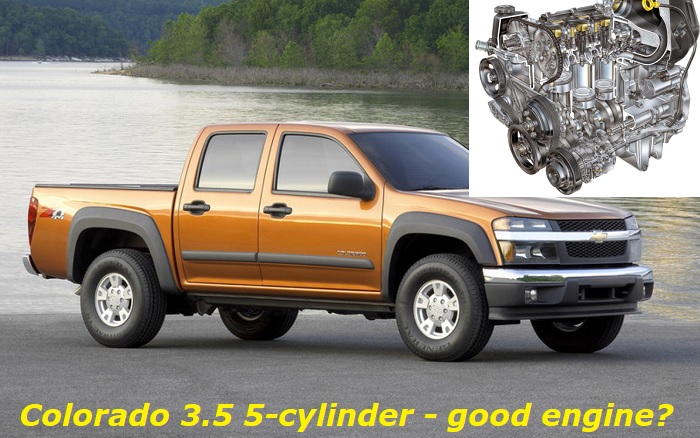The GM 3.5-liter five-cylinder engine, also known as the L52 and Vortec 3500, is popularly known for its application in the Chevrolet Colorado, Hummer H3, GMC Canyon, and Isuzu i-350. Despite its promising design and performance figures, it was a rather short-lived product by GM, which was only produced between 2004 and 2006.
In this article, we will explore whether or not it was a good call on the part of GM to pull the plug off this engine model after only being in production for three years. Factors such as the durability, common problems, and key specs of the engine will be presented here to help us evaluate the decision of the automaker.

Key features and my opinion about the engine
- Production years:2004-2006
- Average lifespan of L52:220,000-260,000 miles
- Fuel supply type:port injection
- Power range:220 hp
- Fuel efficiency:average
- Engine block material:aluminum
- Engine reliability score:medium
- The most common problems:fuel injector problems, ignition issues, weak sensors, oil consumption.
The durability of the Chevrolet Colorado 3.5L 5-Cylinder Engine
The infrastructure of the Chevy 3.5L i5 L52 or Vortec 3500 engine consists of aluminum alloy for its block and head making it durable and also lightweight. Based on some accounts of vehicle owners, the unit can last up to 220,000 miles before needing an overhaul or major parts replacement. This is coupled with proper care and regular maintenance intervals though.
There were many owners who weren't as fortunate, however. Some have experienced serious problems in their units right around the 100,000-mile mark.
Head over to the next section for a more thorough discussion of the common problems pestering owners of the 3.5L inline-five engine over the past few years.
Common Problems of the Chevrolet Colorado 3.5L 5-Cylinder Engine
According to owners' feedback in forums, review, and automotive publications, the following are the common problems that they have experienced in their Chevrolet Colorado 3.5-liter five-cylinder engine:
1. Fuel Injector Failure
Injector failure in the 3.5-liter inline-five engine used by the Chevrolet Colorado can be difficult to diagnose immediately. However, some symptoms can help you identify the problem and possible solutions.
One symptom of injector failure is misfiring. This can be caused by a variety of factors, including carbon build-up, deposits on the injector tip, or a damaged coil. Another symptom is a decrease in fuel economy. This can be caused by leaking injectors, which allow fuel to enter the engine cylinder when it's not needed.
If you think you have an injector failure, the first step is to check the engine codes. This can be done with a code reader or scanner. If you see any codes related to the fuel injectors, it's important to have the problem diagnosed and repaired as soon as possible.
Another way to check for injector failure is to use a multimeter to test the resistance of the injector coils. If the resistance is not within the specified range, it's a sign that the injector is failing.
Injector failure can cause serious engine damage if left unchecked. Once these symptoms start showing up, better zero in on the primary cause of the problem immediately.
If the fuel injector is only dirty and still in good condition, you may still save it through cleaning using a special kit. However, if it is already showing signs of damage, have it replaced right away.
2. Crankshaft Bolt Malfunction
The most common symptom of crankshaft bolt malfunction is oil leaks. If you see oil leaking from your Colorado, then it's likely that the crankshaft bolts are not tightened properly. You can fix this by tightening the bolts yourself. Look for broken seals as they may be triggering the issue, too. In this case, replacing the seals is a must.
Another symptom of crankshaft bolt malfunction is engine misfire. If your Colorado's engine starts to misfire, then it's likely that the crankshaft bolts are loose or improperly fitted. Again, you can fix this by tightening the bolts yourself. Remember to apply the recommended torque when doing this.
One more angle to look at is worn and damaged bolts. Change the faulty bolt as soon as possible, and don't forget to tighten the bolt appropriately.
3. Rough Idles
Rough idling can be due to one or a series of problems within the L52 Vortec 3500 engine. The common culprits are ignition system, fuel system, engine, and sensor issues.
a. Ignition System Problem
If your Chevrolet Colorado has a rough idle, it could be due to an ignition system problem. The ignition system includes spark plugs, wires, and coils. If any of these components are not working properly, it can cause the engine to misfire and run roughly.
To check if the ignition system is the cause of the problem, remove the spark plug wires one at a time and see if the engine idles smoothly. If it does, then you know that one of the wires is causing the problem. Replace the wire and see if that fixes the issue.
If removing the spark plug wires does not fix the problem, then check each spark plug to see if it is fouled or worn out. If any of the spark plugs are damaged, replace them and see if that fixes the problem.
b. Fuel System Problem
If the ignition system is not the cause of the rough idle, then it could be due to a problem with the fuel system. The fuel system includes fuel injectors, a fuel pump, and a fuel filter. If any of these components are not working properly, it can cause the engine to run roughly.
To check if the fuel system is the cause of the problem, you will probably need to consult with a specialist. Checking the injectors on your own is pretty much impossible unless you have some experience as a car mechanic.
If chekcing the fuel injectors does not fix the problem, then check the fuel filter to see if it is clogged. If it is, replace the filter and see if that fixes the problem.
c. Engine Problem
If neither the ignition system nor the fuel system is the cause of the rough idle, then there could be a problem with the engine itself. Some common engine problems that can cause a rough idle include a dirty air filter, low oil level, or a leaking intake manifold.
To check if the engine is the cause of the problem, remove the air filter and see if the engine idles smoothly. If it does, then you know that a dirty air filter was causing the problem. Clean or replace the air filter and see if that fixes the issue.
If removing the air filter does not fix the problem, then check the oil level to see if it is low. If it is, add more oil and see if that fixes the problem.
If neither of these solutions fixes the rough idle, then there could be a leak in the intake manifold. To check for this, remove the intake manifold and look for any cracks or leaks. If you find any, repair or replace the manifold and see if that fixes the problem.
d. Sensor Problem
If none of the above solutions fix the rough idle, then it could be due to a problem with one of the sensors. The sensors that are most likely to cause a problem are the mass airflow sensor, throttle position sensor, or crankshaft position sensor.
To check if a sensor is the cause of the problem, replace each sensor one at a time and see if the engine idles smoothly. If it does, then you know that one of the sensors is causing the problem. Replace the sensor and see if that fixes the issue.
If none of these solutions fix the rough idle, then it could be due to several other issues. Some other possible causes include a clogged catalytic converter, a bad oxygen sensor, or a leaking exhaust manifold. If you have checked all of the above and are still having problems, then it is best to take your vehicle to a mechanic for further diagnosis.
Chevrolet Colorado 3.5L 5-Cylinder Engine Specs
At present, we are so used to engines with even numbers in their cylinders. So, there were questions as to why GM went in the direction of five-cylinders instead of simply going for the four- or six-cylinder design.
The reasoning behind the move is to offer an engine that can deliver better fuel economy and performance than the six-cylinder unit while having more power and torque figures in comparison to the four-cylinder unit. The perceived improvement in fuel efficiency also translates to lesser emissions.
In addition, a five-cylinder engine is seen to get less internal friction than its six-pot counterpart because of the reduction of a single cylinder. The performance gap is then filled by proper tuning to match the power of the six-pot engine. The profile of the unit contributes to its quieter operation, too, compared to the other types mentioned here.
Finally, the five-cylinder engine is more compact than either the four- or six-cylinder engine. One less cylinder means the unit is more compact and can fit in smaller engine bays.
As for its specs, the L52 engine is a straight five with a double overhead camshaft (DOHC) and four-valves per cylinder configuration. It is made of aluminum block and head materials to give it a lightweight construction. The unit possesses a displacement of 3,460cc with a bore of 3.66 inches, a stroke of 4.02 inches, and a compression ratio pegged at 10.0:1.
The 3.5L five-cylinder is capable of producing up to 220 hp at 5,600 rpm and 225 lb-ft at 2,800 rpm. It has a redline of 6,300 rpm.
Paired with the Chevy Colorado of its time, the engine allows the pickup truck to accelerate from 0 to 60 mph between seven to nine seconds. It powers the vehicle to accumulate a top speed of up to 105 mph as well.
Is the Chevy 3.5L 5-Cylinder a Good Engine?
The specs of the Chevrolet Colorado 3.5-liter inline-five Vortec 3500 engine certainly look good on paper. However, this matter is subject to debate as there are also major issues associated with it.
So, was GM right to ax it from its production lines? Probably yes, but it certainly paved way for the development of more improved engines from its manufacturer, hence, it remains an important part of the engine history of the American automaker.
About the authors
The CarAraC research team is composed of seasoned auto mechanics and automotive industry professionals, including individuals with advanced degrees and certifications in their field. Our team members boast prestigious credentials, reflecting their extensive knowledge and skills. These qualifications include: IMI: Institute of the Motor Industry, ASE-Certified Master Automobile Technicians; Coventry University, Graduate of MA in Automotive Journalism; Politecnico di Torino, Italy, MS Automotive Engineering; Ss. Cyril and Methodius University in Skopje, Mechanical University in Skopje; TOC Automotive College; DHA Suffa University, Department of Mechanical Engineering






Add comment